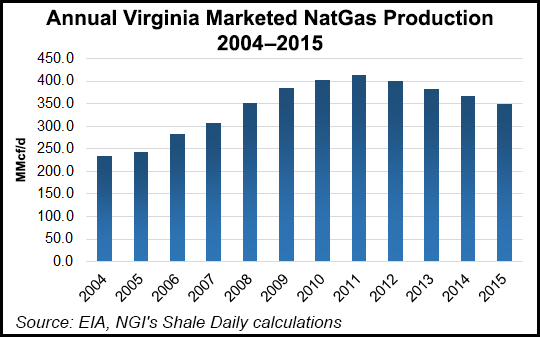Regulatory | E&P | NGI All News Access
Virginia Revises Regulations to Expand Disclosure of Frack Chemicals
Virginia Gov. Terry McAuliffe recently approved changes to the state’s Gas and Oil Regulation that govern the use of hydraulic fracturing (fracking) in the Old Dominion state.

The regulations were authored by Virginia’s Department of Mines, Minerals and Energy (DMME) to expand disclosure of ingredients used in well stimulation, and to ensure that the regulations reflect current industry best practices. DMME adopted the changes to the Virginia Gas and Oil Regulation in September, based on input from an advisory panel that included representatives from industry, environmental groups, other state agencies and local governments.
“The final regulation requires disclosure of the ingredients used in hydraulic fracturing operations to the public while also protecting industry trade secrets except in case of emergency,” according to DMME. “These requirement strike the appropriate balance between environmental protection and economic development as required by the Virginia Gas and Oil Act.” The regulation requires well operators to use the FracFocus registry to disclose chemicals used in fracking operations.
The final regulation also establishes a groundwater sampling, analysis and monitoring program, and adds language strengthening case and pressure testing requirements for well casings used in conventional and coalbed methane gas wells.
While the language in the regulations requiring disclosure of fracking chemicals is welcomed by environmental groups, it could be undermined by a bill due for consideration by the next Virginia General Assembly, according to the Southern Environmental Law Center (SELC). The proposal would create a trade secrets exemption from public disclosure under the state’s Freedom of Information Act (FOIA), SELC attorney Kristen Davis said.
“A FOIA exemption would allow oil and gas companies to keep this information secret at the expense of public health. As the new regulations confirm, information about these chemicals is especially important to communities and emergency responders charged with protecting public health and the environment,” Davis said. “The General Assembly should not roll back this essential new protection.”
There were 8,113 wells producing natural gas in Virginia last year, and 6,896 (85%) of them were fracked wells, a DMMR spokesperson told NGI.
Two years ago, officials in Washington County, VA, approved a change to local zoning laws to open the county to natural gas development, which could include the use of fracking to extract natural gas locked in limestone, sandstone and some deeper shale formations (see Daily GPI, Sept. 12, 2014). At the time, no applications to drill had been submitted to the southwestern Virginia county, which shares a border with Tennessee. DMME geologists believe Washington County is prospective to the Little Valley and Price formations, which are limestone and sandstone formations, respectively, and there are indications of some deeper shale formations.
© 2024 Natural Gas Intelligence. All rights reserved.
ISSN © 2577-9877 | ISSN © 2158-8023 |
